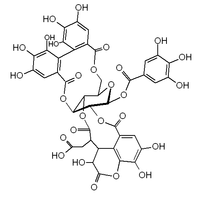- Chebulagic acid
-
Chebulagic acid Identifiers CAS number 23094-71-5 
PubChem 12400 ChEMBL CHEMBL525240 
Jmol-3D images Image 1 - C1C2C3C(C(C(O2)OC(=O)C4=CC(=C(C(=C4)O)O)O)OC(=O)C5=CC(=C(C6=C5C(C(C(=O)O3)CC(=O)O)C(C(=O)O6)O)O)O)OC(=O)C7=CC(=C(C(=C7C8=C(C(=C(C=C8C(=O)O1)O)O)O)O)O)O
- InChI=1S/C41H30O27/c42-13-1-8(2-14(43)24(13)49)35(56)68-41-34-33-31(64-39(60)12(6-19(47)48)22-23-11(38(59)67-34)5-17(46)27(52)32(23)65-40(61)30(22)55)18(63-41)7-62-36(57)9-3-15(44)25(50)28(53)20(9)21-10(37(58)66-33) 4-16(45)26(51)29(21)54/h1-5,12,18,22,30-31,33-34,41-46,49-55H,6-7H2,(H,47,48)/t12-,18+,22-,30-,31+,33-,34+,41-/m0/s1
Key: HGJXAVROWQLCTP-YABCKIEDSA-N
Properties Molecular formula C41H30O27 Molar mass 954.66 g/mol Exact mass 954.097446  acid (verify) (what is:
acid (verify) (what is:  /
/ ?)
?)
Except where noted otherwise, data are given for materials in their standard state (at 25 °C, 100 kPa)Infobox references Chebulagic acid is a benzopyran tannin antioxidant that has many potential uses in medicine.
It has been found to be immunosuppressive,[1] hepatoprotective,[2] and a potent alpha-glucosidase inhibitor, a human gut enzyme useful in diabetic studies. It has been shown to be active against Staphylococcus aureus and Candida albicans[3]
It is found in the plants Terminalia chebula, T. citrina and T. catappa.[4]
References
Carbohydrates Types Ellagitannins | Gallotanninsunclassified Chebulagic acid | Chebulinic acid | Cinchotannic acid | Combreglutinin | Flavogallonic acid | Flavogallonic acid dilactone | Geraniin | Granatin B | Hipophaenin D | Isostrictinin | Kinotannic acid | Stachyurin | Stenophyllanin A | Strictinin | Tannic acid | Tercatin | Tergallagin | Theograndins I and II | Vescalin | Valoneic acid | Valoneic acid dilactone | Vescavaloneic acid/Castavaloneic acidOther Tannin sources | TannateThis article about a natural phenol is a stub. You can help Wikipedia by expanding it.

